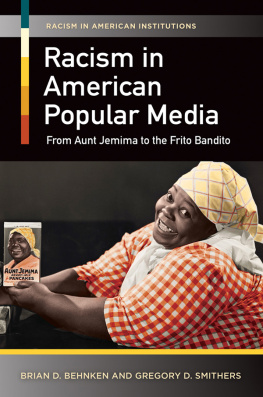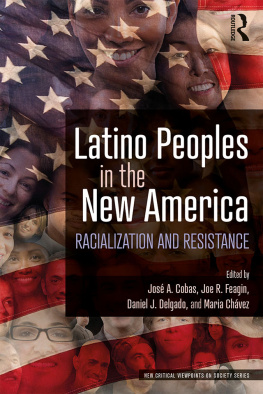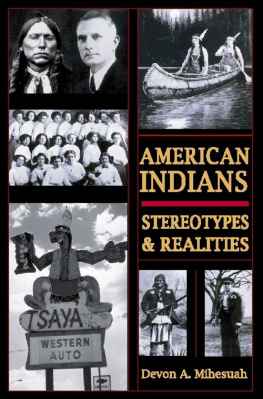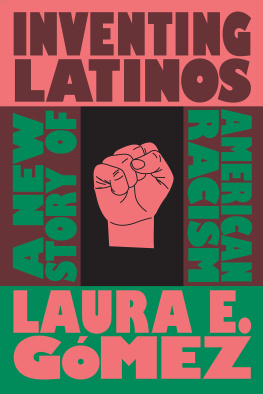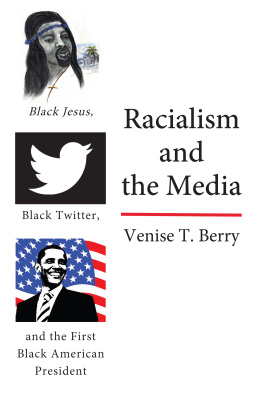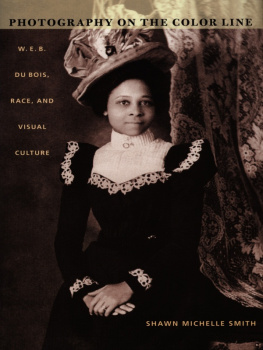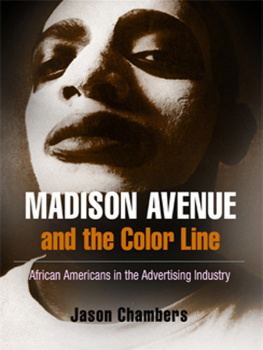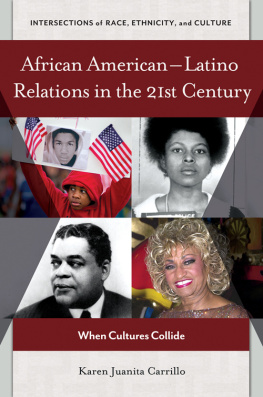Racism in American Popular Media
Recent Titles in Racism in American Institutions
Brian D. Behnken, Series Editor
The Color of Politics: Racism in the American Political Arena Today
Chris Danielson
How Do Hurricane Katrinas Winds Blow?: Racism in 21st-Century New Orleans
Liza Lugo, JD
Out of Bounds: Racism and the Black Athlete
Lori Latrice Martin, Editor
Color behind Bars: Racism in the U.S. Prison System
Volume 1: Historical and Contemporary Issues of Race and Ethnicity in the American Prison System
Volume 2: Public Policy Influence(s) toward a Racial/Ethnic American Prison System
Scott Wm. Bowman, Editor
White Sports/Black Sports: Racial Disparities in Athletic Programs
Lori Latrice Martin
Racism in American Popular Media
From Aunt Jemima to the Frito Bandito
BRIAN D. BEHNKEN AND GREGORY D. SMITHERS
Racism in American Institutions
Brian D. Behnken, Series Editor

Copyright 2015 by Brian D. Behnken and Gregory D. Smithers
All rights reserved. No part of this publication may be reproduced, stored in a retrieval system, or transmitted, in any form or by any means, electronic, mechanical, photocopying, recording, or otherwise, except for the inclusion of brief quotations in a review, without prior permission in writing from the publisher.
Library of Congress Cataloging-in-Publication Data
Behnken, Brian D.
Racism in American popular media : from Aunt Jemima to the Frito Bandito / Brian D. Behnken and Gregory D. Smithers.
pages cm. (Racism in American institutions)
Includes bibliographical references and index.
ISBN 978-1-4408-2976-5 (hardback)ISBN 978-1-4408-2977-2 (ebook)1.Mass media and race relationsUnited States.2.Racism in mass mediaUnited States.3.Mass media and minoritiesUnited States. I.Smithers, Gregory D., 1974II. Title.
P94.5.M552U625 2015
305.8dc232014042819
ISBN: 978-1-4408-2976-5
EISBN: 978-1-4408-2977-2
191817161512345
This book is also available on the World Wide Web as an eBook.
Visit www.abc-clio.com for details.
Praeger
An Imprint of ABC-CLIO, LLC
ABC-CLIO, LLC
130 Cremona Drive, P.O. Box 1911
Santa Barbara, California 93116-1911
This book is printed on acid-free paper 
Manufactured in the United States of America
Contents
Racism in American Popular Media: From Aunt Jemima to the Frito Bandito is the first book to be published in Praeger Publishers series, Racism in American Institutions (RAI), that examines the ways in which racism has become institutionalized in the media. The RAI series focuses on the ways in which racism has become, and remains, a part of the fabric of many American institutions. For example, while the United States may have done away with overtly racist acts such as extralegal lynching, racism still affects many of Americas established institutions from public schools to corporate offices. Schools may not be legally segregated, and yet many districts are not integrated. While the media discarded many of its most racist practices and characters years ago, examples of black people depicted as criminals, Latinos depicted as lazy, or Native Americans depicted as disappearing savages remain with us. This open-ended series of works examines the problem of racism in established American institutions. Each book in the RAI series traces the prevalence of racism within a particular institution throughout the history of the United States and explores the problem in that institution today, looking at ways in which the institution has attempted to rectify racism, but also the ways in which it has not.
In Racism in American Popular Media, RAI series editor Brian D. Behnken has teamed up with historian Gregory D. Smithers to offer a broad-ranging account of racism in the media. We contend that racism not only became institutionalized in the popular media, but that racist caricatures and stereotypical depictions were some of the earliest, and most popular, features of the print (both fiction and nonfiction), advertising, and motion picture (later cartoons and television) industries. One need look no further than early fiction and nonfiction to see examples of works that explored racial difference and always cast persons of color in a negative light. These include popular racist nonfiction accounts such as Charles Carrolls The Negro, A Beast and popular fictional works such as Sax Rohmers The Insidious Dr. Fu-Manchu. Advertisers learned quickly that race and racism helped sell products, so featuring a mammy figure like Aunt Jemima on a box of ready-to-make pancake mix made sense to advertisers. In other cases products used gross names on their labels as well, from Nigger Head Stove Polish to Sambo Watermelon. Hollywood also participated in this racism, producing numerous early films focusing on race and racism, from the well-known Birth of a Nation to the now largely forgotten Broncho Billy and The Greaser. Eventually ethnic communities grew tired of this treatment and demanded that the media create more positive portrayals of minorities. This took the form of civil rights campaigns, from the National Association for the Advancement of Colored Peoples protests against Birth of a Nation to the Mexican American communitys protests of the Frito Bandito character.
Brian D. Behnken and Gregory D. Smithers are well positioned to explore the history of racism in the popular media. Both are historians by training who have lengthy publication records that have examined racism, popular culture, and civil rights activism within a multidisciplinary framework. Racism in American Popular Media builds on their expertise, fleshing out not only the long history of racism in the popular media, but also examining the ways in which people of color have challenged this racism.
Brian D. Behnken
Iowa State University
Ames, Iowa
At the dawn of the twenty-first century, popular forms of media surround us, permeating almost every waking moment of our lives. Popular media has proliferated to such an extent that scholars have scrambled over the past generation to make sense of it all. Detailed analyses by cultural historians and media studies experts have identified a dizzying array of popular media, from emerging niche cultures involving Internet sites like YouTube or Facebook to massive content deliverers such as Netflix and Amazon Prime, from books or newsmagazines to what are now seen as traditional pop culture formats such as film and television.
Popular media, however, has a long history in North America that stretches farther back in time than the advent of moving pictures, television, and the Internet. Native Americans, for example, expressed their own forms of popular culture in their daily routines, songs, ceremonies, and stories, long before Africans and Europeans arrived in the Americas. When African and European peoples did begin arriving in the New World during the fifteenth and sixteenth centuries, they brought with them their own ideas, cultures, and forms of expression. In what became the United States, the intertwining of Native American, African, and European lives brought different cultures and belief systems together; some of these amalgamated to produce distinctively American forms of expression and cultural practices. Most significantly, the process of cultural retention, amalgamation, and reinvention occurred in colonial contexts in which social, political, economic, and military power was negotiated and/or fought over. That the British, and subsequently the Anglo-Americans, prevailed in stamping their vision of social and cultural order on the geographical and human landscape of North America provides us with a revealing entry point with which to study race and racism in American popular media during the nineteenth and twentieth centuries.

